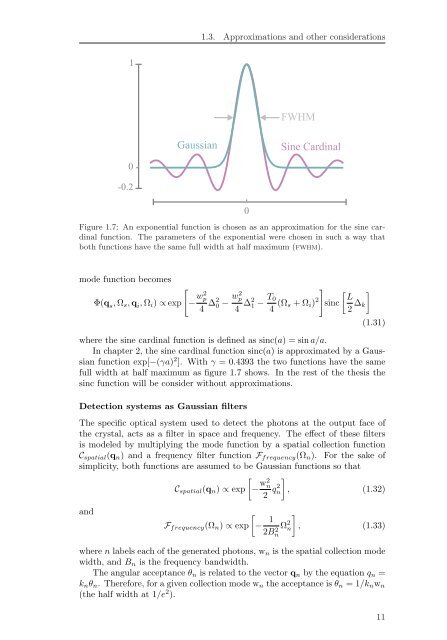Spatial Characterization Of Two-Photon States - GAP-Optique
Spatial Characterization Of Two-Photon States - GAP-Optique
Spatial Characterization Of Two-Photon States - GAP-Optique
You also want an ePaper? Increase the reach of your titles
YUMPU automatically turns print PDFs into web optimized ePapers that Google loves.
1<br />
0<br />
-0.2<br />
1.3. Approximations and other considerations<br />
Gaussian Sine Cardinal<br />
0<br />
FWHM<br />
Figure 1.7: An exponential function is chosen as an approximation for the sine cardinal<br />
function. The parameters of the exponential were chosen in such a way that<br />
both functions have the same full width at half maximum (fwhm).<br />
mode function becomes<br />
Φ(q s, Ωs, q i, Ωi) ∝ exp<br />
<br />
− w2 p<br />
4 ∆2 0 − w2 p<br />
4 ∆2 1 − T0<br />
4 (Ωs + Ωi) 2<br />
<br />
sinc<br />
<br />
L<br />
2 ∆k<br />
<br />
(1.31)<br />
where the sine cardinal function is defined as sinc(a) = sin a/a.<br />
In chapter 2, the sine cardinal function sinc(a) is approximated by a Gaussian<br />
function exp[−(γa) 2 ]. With γ = 0.4393 the two functions have the same<br />
full width at half maximum as figure 1.7 shows. In the rest of the thesis the<br />
sinc function will be consider without approximations.<br />
Detection systems as Gaussian filters<br />
The specific optical system used to detect the photons at the output face of<br />
the crystal, acts as a filter in space and frequency. The effect of these filters<br />
is modeled by multiplying the mode function by a spatial collection function<br />
Cspatial(qn) and a frequency filter function Ffrequency(Ωn). For the sake of<br />
simplicity, both functions are assumed to be Gaussian functions so that<br />
<br />
Cspatial(qn) ∝ exp − w2 n<br />
2 q2 <br />
n , (1.32)<br />
and<br />
<br />
Ffrequency(Ωn) ∝ exp − 1<br />
2B2 Ω<br />
n<br />
2 <br />
n , (1.33)<br />
where n labels each of the generated photons, wn is the spatial collection mode<br />
width, and Bn is the frequency bandwidth.<br />
The angular acceptance θn is related to the vector qn by the equation qn =<br />
knθn. Therefore, for a given collection mode wn the acceptance is θn = 1/knwn<br />
(the half width at 1/e 2 ).<br />
11



